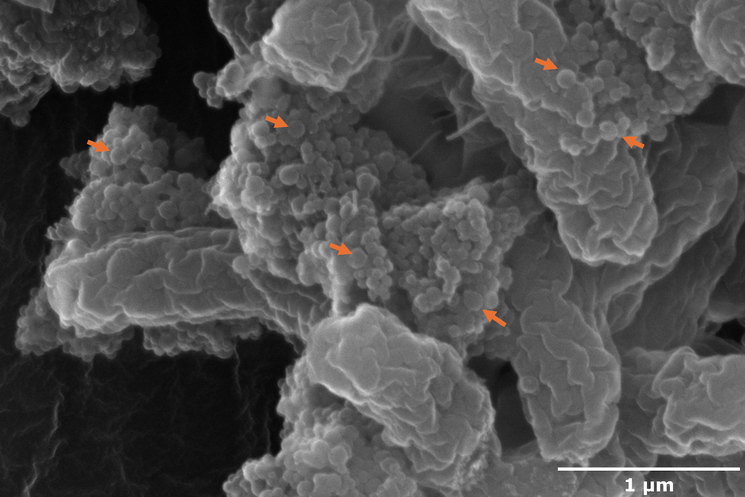Reviewed by Lexie CornerMay 20 2025
There are nanoplastics everywhere. These particles are found in water, food, and bodies; they are so small that they can accumulate on bacteria and be absorbed by plant roots. While the full impact of nanoplastics on human health is still unclear, recent research by food scientists at the University of Illinois Urbana-Champaign suggests that certain nanoplastics may increase the virulence of foodborne viruses.
 Clusters of nanoplastics (red arrows) bind to E. coli O157:H7. Award-winning image by Jayashree Nath, First Author of the study. Image Credit: University of Illinois Urbana-Champaign
Clusters of nanoplastics (red arrows) bind to E. coli O157:H7. Award-winning image by Jayashree Nath, First Author of the study. Image Credit: University of Illinois Urbana-Champaign
Other studies have evaluated the interaction of nanoplastics and bacteria, but so far, ours is the first to look at the impacts of microplastics and nanoplastics on human pathogenic bacteria. We focused on one of the key pathogens implicated in outbreaks of foodborne illness, E. coli O157:H7.
Pratik Banerjee, Senior Study Author and Associate Professor, University of Illinois Urbana-Champaign
According to Banerjee's team, E. coli O157:H7 was more likely to experience physiological stress when exposed to nanoplastics with positively charged surfaces. The stressed bacteria became more virulent, releasing more Shiga-like toxin - the chemical that causes illness in humans - much like a stressed dog is more likely to bite.
Since the surface of E. coli is negatively charged, the researchers anticipated that positively charged nanoplastics would affect the bacteria. They created nanoplastics from polystyrene, the material used in common white clamshell takeout boxes, and applied positive, neutral, or negative charges before exposing the particles to E. coli, either free-floating in solution or in biofilms, to test their opposites-attract theory.
Banerjee added, “We started with the surface charge. Plastics have an enormous ability to adsorb chemicals. Each chemical has a different effect on surface charge, based on how much chemical is adsorbed and on what kind of plastic. We did not look at the effects of the chemicals themselves in this paper; that is our next study, but this is the first step in understanding how the surface charge of plastics impacts pathogenic E. coli response.”
Bacteria exposed to positively charged nanoplastics showed signs of stress in several ways, including increased production of Shiga-like toxin. They also multiplied more slowly when free-floating and accumulated in biofilms. However, their growth eventually recovered.
Biofilms provide bacterial cells with some protection by forming an extracellular covering. To test whether this covering could shield bacteria from nanoplastic-induced stress, the researchers immersed relatively large microplastic particles in a bacterial culture and allowed E. coli to grow for one to two weeks. They then introduced the same charged nanoplastics.
The positively charged particles continued to cause stress and increased Shiga-like toxin production in E. coli within biofilms.
Banerjee stated, “Biofilms are a very robust bacterial structure and are hard to eradicate. They are a big problem in the medical industry, forming on inserts like catheters or implants, and in the food industry. One of our goals was to see what happens when this human pathogen, which is commonly transmitted via food, encounters these nanoplastics from the vantage point of a biofilm.”
Interactions with plastic particles may do more than increase E. coli toxicity; other studies have shown that biofilms on microplastics can act as hotspots for the transfer of antibiotic resistance genes, making the bacteria more difficult to control. Banerjee’s group is currently investigating resistance gene transfer, as well as changes in the virulence and transmission patterns of major foodborne pathogens in food products and environments such as soil.
Source:
Journal reference:
Nath, J., et al. (2025) Nanoplastics-mediated physiologic and genomic responses in pathogenic Escherichia coli O157:H7. Journal of Nanobiotechnology. doi.org/10.1186/s12951-025-03369-z.